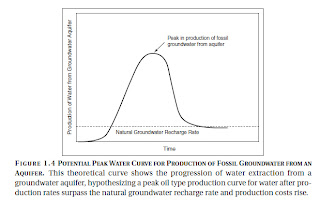The term "peak water" is analogous to the term "peak oil." It refers to a point at which the withdrawal rate and demand of water is the highest level, after which it drops due to shortness in supply.
Today, humans already use 50% of freshwater flows directly or indirectly, and 1/3 of the world's population live in areas experiencing moderate to high water stress.
The UN predicts that by 2020, water use will increase by 40% and 17% more water will be required to produce food for the growing population.
According to a study by the UNEP in 2007, by 2025, 1.8 billion people in the world will be living in regions with absolute water scarcity and 2/3 of people will be living in conditions where the water supply is stressed.
When drawing comparisons between the oil crisis and water crisis, we can note that both oil and freshwater supplies are finite. However, oil is non-renewable and consumptive (after it is used, it changes into heat and other byproducts), while water is a renewable resource on a global level and not consumptive.
As well, oil as a source of energy can be substituted by other resources, but water cannot be substituted for the purposes it serves.
.
-http://www.worldwater.org/data20082009/Table1.pdf <-- See this document for values of how much water is available per square kilometer in every country worldwide.
Aquifer depletion in relation to Peak Water
Aquifers are localized points of water underground that renew very slowly--- far slower than required to replace stocks used.
Citation
Gleick, Peter H., and Meena Palaniappan. The World's Water. Island's Press, 2009. Accessed November 8th, 2010. http://www.worldwater.org/data20082009/ch01.pdf
Mona Dai Nov 8th, 2010


No comments:
Post a Comment